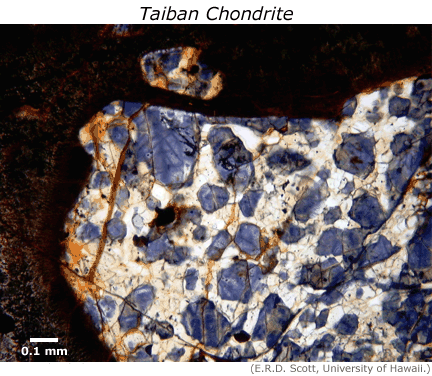Ringwoodite
High-pressure olivineGroup of silicate minerals, (Mg,Fe)2SiO4, with the compositional endpoints of forsterite (Mg2SiO4) and fayalite (Fe2SiO4). Olivine is commonly found in all chondrites within both the matrix and chondrules, achondrites including most primitive achondrites and some evolved achondrites, in pallasites as large yellow-green crystals (brown when terrestrialized), in the silicate portion Click on Term to Read More polymorph with a spinelMg-Al oxide, MgAl2O4, found in CAIs. structure that is found in highly shocked meteorites (above ~50 GPa, shock levelA petrographic assessment, using features observed in minerals grains, of the degree to which a meteorite has undergone shock metamorphism. The highest stage observed in 25% of the indicator grains is used to determine the stage. Also called "shock level". Click on Term to Read More > S5) and the Earth’s transition zone mantleMain silicate-rich zone within a planet between the crust and metallic core. The mantle accounts for 82% of Earth's volume and is composed of silicate minerals rich in Mg. The temperature of the mantle can be as high as 3,700 °C. Heat generated in the core causes convection currents in Click on Term to Read More (~13 GPa). Under even higher pressure in the lower mantle (~24 GPa), ringwoodite decomposes into perovskiteTerm applied to A2+B4+O3 high-pressure minerals with a perovskite structure (general formula ABX3) where "A" is a metal that forms large cations such as Mg, Fe or Ca, "B" is another metal that forms smaller cations such as Si (called silicate perovskite), Ti and to a lesser degree Al, and Click on Term to Read More (Mg,Fe)SiO3, and magnesiowüstite (Mg,Fe)O, whose properties are completely different. This transformation explains the observed discontinuity between Earth’s upper and lower mantle. At lower pressure, ringwoodite transforms into wadsleyiteHigh pressure polymorph of olivine, β-Mg2SiO4, found on Earth and in some meteorites. It is thought to make up 50% or more of Earth's mantle between depths of 400 and 525 km. Wadsleyite transforms into ringwoodite at high pressure, but the exact pressure depends strongly on composition. At lower pressures,, another olivine polymorph.

Natural ringwoodite is generally more Mg-rich,but, like olivine, it does form a continuous solid solutionCompositional variation resulting from the substitution of one ion or ionic compound for another ion or ionic compound in an isostructural material. This results in a mineral structure with specific atomic sites occupied by two or more ions or ionic groups in variable proportions. Solid solutions can be complete (with series whose end-members also range from pure Mg to pure Fe. Iron‐enriched ringwoodite has been documented from only a handful of meteorites. Natural ringwoodite was first discovered in shock-melt veins within the Tenham meteorite in 1969: “The [ringwoodite] grains occur chiefly within black veins cutting across the stones, but the same material also replaces olivine within 10 – 20 microns of certain thicker veins and at the margins of some large chondritic fragments within the veins. Our investigations show that the purple mineralInorganic substance that is (1) naturally occurring (but does not have a biologic or man-made origin) and formed by physical (not biological) forces with a (2) defined chemical composition of limited variation, has a (3) distinctive set of of physical properties including being a solid, and has a (4) homogeneous Click on Term to Read More is the high pressure spinel polymorph of olivine, and for this first authentic natural occurrence we propose the name ringwoodite, in honour of the experimental studies by Professor A. E. Ringwood, Australian National University. The name covers the entire range of (Mg,Fe)2SiO4 spinels …”
Beyond its its initial discovery in chondritesChondrites are the most common meteorites accounting for ~84% of falls. Chondrites are comprised mostly of Fe- and Mg-bearing silicate minerals (found in both chondrules and fine grained matrix), reduced Fe/Ni metal (found in various states like large blebs, small grains and/or even chondrule rims), and various refractory inclusions (such Click on Term to Read More, ringwoodite has also been found in and around shock veins within Martian and lunar meteoritesAchondrite meteorites from the surface of the Moon. Most were found in the hot deserts of northern Africa and Oman and others were found in the cold desert of Antarctica, although one, a 19-gram specimen, was recovered in 1990 from Calcalong Creek, Australia. These stones are of great importance because, Click on Term to Read More. In an unusual twist of events, ringwoodite was found in a terrestrial specimen much later than it was found in meteorites. The first natural occurence of a terrestrial ringwoodite came in 2014, when a small ringwoodite crystal was found enclosed in a diamondOne of the naturally occurring forms of carbon found in meteorites. Each C atom is bonded through covalent sp3 hydrid orbitals to four others. The strength of the C-C bonds makes diamond the hardest naturally occurring substance (according to the Mohs scale) in terms of resistance to scratching. There are Click on Term to Read More whose primary source was in the deep mantle region, far lower than a typical diamond would normally originate.
Ringwoodite is able to contain hydroxide ions (OH−) within its structure. As such, research suggests that vast quantities of water (H2O) may be trapped in the Earths transition zone mantle. Recent research has shown that both iron-free and iron-bearing ringwoodite can store about 0.8-1.2 wt.% of H2O under mantle transition zone conditions and temperatures of 1600 – 2000 K.
Ringwoodite can appear dark blue or purple in meteorites due to the absorbtion of red light that occurs during the exchange of an electron between the iron ions, Fe2+ and Fe3+.
Some or all content above used with permission from J. H. Wittke.






